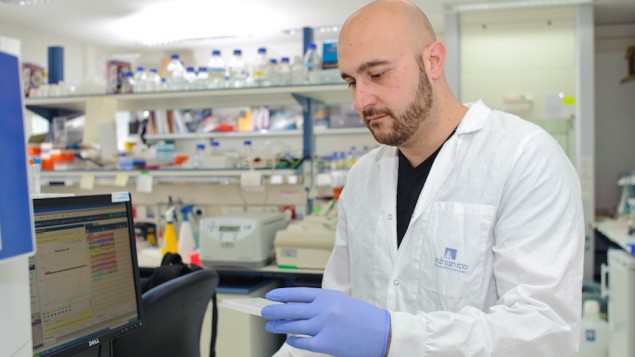
A step toward curing infertility
Jan. 2015
Cell breakthrough a step toward curing infertility
Medical development could one day help tens of millions of people who can’t start families
Scientists at the Weizmann Institute of Science in Rehovot, Israel, working with a team at Cambridge University, have successfully created primordial germ cells (PGCs) – the embryonic cells that give rise to sperm and ova – in a test tube.
The breakthrough, which scientists have been pursuing for years, according to Dr. Jacob (Yaqub) Hanna of the Institute’s Molecular Genetics Department, could one day provide a solution for infertile men and women, allowing individuals who have undergone medical traumas like chemotherapy or age-related events such as menopause to once again produce children.
“Of course, much more work is needed to accomplish that,” said Hanna. “A number of hurdles remain before labs will be able to complete the chain of events that move an adult cell through the cycle of embryonic stem cell and around to sperm or ova.” Still, he said, he is “confident that those hurdles will one day be overcome.”
The results of the work, which has been published in the academic journal Cell, could help provide answers as to the causes of fertility problems, yield insight into the earliest stages of embryonic development and potentially, in the future, enable the development of new kinds of reproductive technology, Hanna added. The breakthrough is especially significant, said Hanna, because this is the earliest iteration of a human cell scientists have been able to create in a lab setting.
PGCs arise within the early weeks of embryonic growth, as the embryonic stem cells in the fertilized egg begin to differentiate into the very basic cell types. Once these primordial cells become “specified,” they continue developing toward precursor sperm cells or ova “pretty much on autopilot,” said Hanna.
The Weizmann/Cambridge research is a direct outgrowth of previous work done on PGCs, based on a discovery made by Japanese researchers in 2006. The researchers developed a method to create a type of stem cell – called an induced pluripotent stem cells, or iPS – directly from regular adult tissues, essentially enabling cells to clone themselves into younger, more vigorous versions. The iPS cells perform similar functions in regenerative medicine to embryonic stem cells without the controversy use of those cells often engenders.
For their work at Kyoto University, Professor Shinya Yamanaka and Sir John Gurdon were awarded the 2012 Nobel Prize in Physiology. Yamanaka and Gurdon did their work on mice, and Hanna’s lab took that research into a new direction, seeking to learn how human iPS cells and mouse embryonic cells differ. Among their findings: Mouse embryonic cells are easily kept in their stem cell state in the lab, while human iPS cells that have been reprogrammed – a technique that involves the insertion of four genes – have a strong drive to differentiate. Fine-tuning that differentiation process, the Weizmann team (led by Hanna and research student Leehee Weinberger) were able to create a new kind of iPS cell – dubbed “naive iPS cells” — that are even more “primordial” on the development scale, closer to their original embryonic state, and from which they can truly differentiate into any cell type. This includes PGC cells, and, based on work by Hanna’s team and the lab group of Prof. Azim Surani of Cambridge University, the researchers discovered that using this method they had converted 40 percent of the iPS cells into PGC cells. Those results are enough to justify optimism that given the tendency of PGC cells to turn into sperm and ova (depending on whether they are found in a male or female), the findings by Hanna and the researchers are an important step in the production of substitute sperm and ova, which can be raised in a test tube and implanted in the human body.
Of course, much more work is needed, Hanna said, and there are hurdles that must be overcome before test-tube sperm and ova can be produced. For example, at some point in the process, the cells must “learn” to divide their DNA in half before they can become viable reproductive cells. But Hanna is confident that this issue can and will be overcome – and that one day, having children will be an option for tens of millions of people who today cannot have families.
Scientists at the Weizmann Institute of Science in Rehovot, Israel, working with a team at Cambridge University, have successfully created primordial germ cells (PGCs) – the embryonic cells that give rise to sperm and ova – in a test tube.
The breakthrough, which scientists have been pursuing for years, according to Dr. Jacob (Yaqub) Hanna of the Institute’s Molecular Genetics Department, could one day provide a solution for infertile men and women, allowing individuals who have undergone medical traumas like chemotherapy or age-related events such as menopause to once again produce children.
“Of course, much more work is needed to accomplish that,” said Hanna. “A number of hurdles remain before labs will be able to complete the chain of events that move an adult cell through the cycle of embryonic stem cell and around to sperm or ova.” Still, he said, he is “confident that those hurdles will one day be overcome.”
The results of the work, which has been published in the academic journal Cell, could help provide answers as to the causes of fertility problems, yield insight into the earliest stages of embryonic development and potentially, in the future, enable the development of new kinds of reproductive technology, Hanna added. The breakthrough is especially significant, said Hanna, because this is the earliest iteration of a human cell scientists have been able to create in a lab setting.
PGCs arise within the early weeks of embryonic growth, as the embryonic stem cells in the fertilized egg begin to differentiate into the very basic cell types. Once these primordial cells become “specified,” they continue developing toward precursor sperm cells or ova “pretty much on autopilot,” said Hanna.
The Weizmann/Cambridge research is a direct outgrowth of previous work done on PGCs, based on a discovery made by Japanese researchers in 2006. The researchers developed a method to create a type of stem cell – called an induced pluripotent stem cells, or iPS – directly from regular adult tissues, essentially enabling cells to clone themselves into younger, more vigorous versions. The iPS cells perform similar functions in regenerative medicine to embryonic stem cells without the controversy use of those cells often engenders.
For their work at Kyoto University, Professor Shinya Yamanaka and Sir John Gurdon were awarded the 2012 Nobel Prize in Physiology. Yamanaka and Gurdon did their work on mice, and Hanna’s lab took that research into a new direction, seeking to learn how human iPS cells and mouse embryonic cells differ. Among their findings: Mouse embryonic cells are easily kept in their stem cell state in the lab, while human iPS cells that have been reprogrammed – a technique that involves the insertion of four genes – have a strong drive to differentiate. Fine-tuning that differentiation process, the Weizmann team (led by Hanna and research student Leehee Weinberger) were able to create a new kind of iPS cell – dubbed “naive iPS cells” — that are even more “primordial” on the development scale, closer to their original embryonic state, and from which they can truly differentiate into any cell type. This includes PGC cells, and, based on work by Hanna’s team and the lab group of Prof. Azim Surani of Cambridge University, the researchers discovered that using this method they had converted 40 percent of the iPS cells into PGC cells. Those results are enough to justify optimism that given the tendency of PGC cells to turn into sperm and ova (depending on whether they are found in a male or female), the findings by Hanna and the researchers are an important step in the production of substitute sperm and ova, which can be raised in a test tube and implanted in the human body.
Of course, much more work is needed, Hanna said, and there are hurdles that must be overcome before test-tube sperm and ova can be produced. For example, at some point in the process, the cells must “learn” to divide their DNA in half before they can become viable reproductive cells. But Hanna is confident that this issue can and will be overcome – and that one day, having children will be an option for tens of millions of people who today cannot have families.
